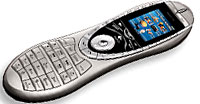 If you haven’t been to CES, you may have heard of the headache inducing noise, leg-ache inducing size and debt-ache inducing taxis and hotel rooms. We’ll save you all that and run over the highs and lows from this year’s CES 2006 show – shame we can’t help out with the glitzy lights of Las Vegas.
If you haven’t been to CES, you may have heard of the headache inducing noise, leg-ache inducing size and debt-ache inducing taxis and hotel rooms. We’ll save you all that and run over the highs and lows from this year’s CES 2006 show – shame we can’t help out with the glitzy lights of Las Vegas.
Noteworthy on the entertainment front was the Saitek A-250, a $129 wireless 2.1 speaker system playing music stored on a PC’s hard drive via Class One Bluetooth technology. The system managed to effortlessly stream music up to 100 feet away from the PC.
 Satellite radios from XM and Sirius while Toshiba’s new HD-DVD playing Qosmio laptop gathered attention. It’s the first laptop to debut with a built-in HD-DVD player. The laptop can also play hi-def discs on your TV. The Qosmio is expected to hit the streets in March 2006 – months before the first Blu-Ray boxes are due out.
Satellite radios from XM and Sirius while Toshiba’s new HD-DVD playing Qosmio laptop gathered attention. It’s the first laptop to debut with a built-in HD-DVD player. The laptop can also play hi-def discs on your TV. The Qosmio is expected to hit the streets in March 2006 – months before the first Blu-Ray boxes are due out.
For multimedia aficionados, PC World reckons the Harmony 890 could take gadget lovers to remote control nirvana, with Logitech’s Harmony 890 Universal Remote using RF technology allowing owners to control consumer electronics located in other rooms and floors.
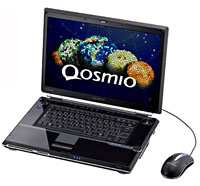 It looks great, but you’ll need deep pockets and an understanding partner to justify forking out $399 for a humble remote control.
It looks great, but you’ll need deep pockets and an understanding partner to justify forking out $399 for a humble remote control.
When it comes to portable video devices, Samsung’s new YM-P1 handheld DVR was described as a “genuinely intriguing product”, offering users the ability to record TV directly to the built in 20GB hard drive for viewing later on the unit’s 4-inch screen. You can expect the device to come out in February, priced around $400.
In the flash-based MP3 player department, SanDisk’s 6GB flash player proved a hit, impressing with its generous storage capacity, pretty-boy looks, feature set and video support.
 Elsewhere, the PC World editors were less than impressed with the ongoing willy-waving battle for the biggest plasma screen, arguing that they’d prefer it if the manufacturer’s considerable energies were directed into producing affordable plasmas for regular folks.
Elsewhere, the PC World editors were less than impressed with the ongoing willy-waving battle for the biggest plasma screen, arguing that they’d prefer it if the manufacturer’s considerable energies were directed into producing affordable plasmas for regular folks.
Read their full list of highlights and lowlights here: CES 2006: Picks and Pans.
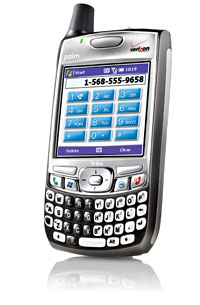 Palm have finally announced the launch of their much anticipated Windows Mobile powered Treo 700w smartphone.
Palm have finally announced the launch of their much anticipated Windows Mobile powered Treo 700w smartphone. The transition to Windows has, however, seen the TFT screen resolution shrink from Palm’s 320 x 320 pixels to a more miserly 240 x 240 pixels (the same as the Treo-alike HP iPAQ hw6500 series). Early reports suggest that the screen is somewhat washed out compared to the current Palm Treo 650.
The transition to Windows has, however, seen the TFT screen resolution shrink from Palm’s 320 x 320 pixels to a more miserly 240 x 240 pixels (the same as the Treo-alike HP iPAQ hw6500 series). Early reports suggest that the screen is somewhat washed out compared to the current Palm Treo 650.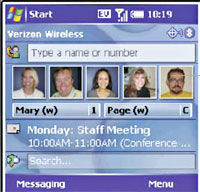 The removable battery gives up to 4.7 hours of talk time or up to 15 days of standby.
The removable battery gives up to 4.7 hours of talk time or up to 15 days of standby.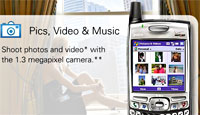 If Palm have successfully managed the transition to the Windows platform, we can expect this new smartphone to be a winner, although we do wonder what long-term impact it may have on their Palm OS range.
If Palm have successfully managed the transition to the Windows platform, we can expect this new smartphone to be a winner, although we do wonder what long-term impact it may have on their Palm OS range.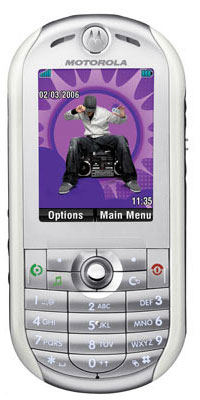 Motorola says adieu to Apple and bonjour to Linux as it unveiled its shiny new ROKR E2 phone at the Consumer Electronics Show today.
Motorola says adieu to Apple and bonjour to Linux as it unveiled its shiny new ROKR E2 phone at the Consumer Electronics Show today.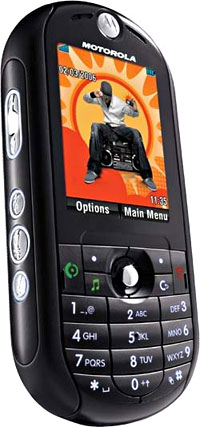 Running on a new Linux-based operating system, the Motorola ROKR E2 also includes a high-res 320×240 screen, a 1.3 megapixel camera with video recording, a built-in FM radio, Opera Web browser Bluetooth (supporting wireless music streaming to stereo Bluetooth headphones), and joy-of-joys – a standard 3.5mm stereo headphone jack and not one of those ruddy annoying mini sockets that are incompatible with normal headphones.
Running on a new Linux-based operating system, the Motorola ROKR E2 also includes a high-res 320×240 screen, a 1.3 megapixel camera with video recording, a built-in FM radio, Opera Web browser Bluetooth (supporting wireless music streaming to stereo Bluetooth headphones), and joy-of-joys – a standard 3.5mm stereo headphone jack and not one of those ruddy annoying mini sockets that are incompatible with normal headphones.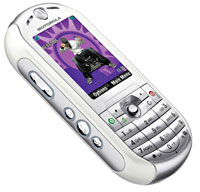 In the absence of iTunes, Motorola intends to push their iRadio Music Service, a subscription music service that uses mobile handsets as the base platform.
In the absence of iTunes, Motorola intends to push their iRadio Music Service, a subscription music service that uses mobile handsets as the base platform.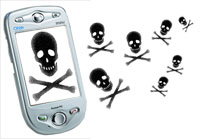 Anti-virus software vendors McAfee Avert Labs have released a dire warning about impending doom for smartphone users, claiming that mobile security threats are expected to triple next year.
Anti-virus software vendors McAfee Avert Labs have released a dire warning about impending doom for smartphone users, claiming that mobile security threats are expected to triple next year.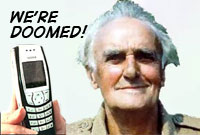 Schmugar claimed that the consumers’ lack of interest in applying security software to their mobile devices (i.e not buying their software) is likely to compound the problem.
Schmugar claimed that the consumers’ lack of interest in applying security software to their mobile devices (i.e not buying their software) is likely to compound the problem. Cambridge outfit, HD Positions, have launched their ‘Boomerang Box’ device, a new low cost, high accuracy positioning system which locates vehicles and other valuable assets.
Cambridge outfit, HD Positions, have launched their ‘Boomerang Box’ device, a new low cost, high accuracy positioning system which locates vehicles and other valuable assets. The service works by HD Positions supplying the interface to Matrix, facilitating related Machine to Machine (M2M) services, including network connectivity, billing and support.
The service works by HD Positions supplying the interface to Matrix, facilitating related Machine to Machine (M2M) services, including network connectivity, billing and support. We tried to find a picture of the actual Boomerang Box, hopeful that it would be an amusing looking thing that would spice up this rather dull report, but there was nothing to be found on their Website.
We tried to find a picture of the actual Boomerang Box, hopeful that it would be an amusing looking thing that would spice up this rather dull report, but there was nothing to be found on their Website.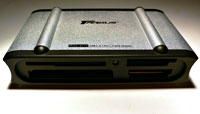 As your collection of digital devices grows, you’ll probably find it near-impossible to stick with just the one memory card format as the pesky things keep on changing.
As your collection of digital devices grows, you’ll probably find it near-impossible to stick with just the one memory card format as the pesky things keep on changing.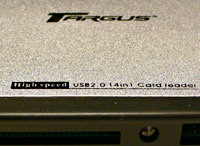 Getting data off these various cards usually means a trip to the back of the PC to install the various cables that came with all your camera/smartphone etc (when will they standardise all the ruddy USB connecters?!).
Getting data off these various cards usually means a trip to the back of the PC to install the various cables that came with all your camera/smartphone etc (when will they standardise all the ruddy USB connecters?!).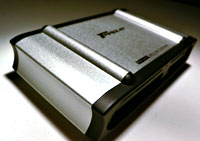 With most memory card readers offering support for a huge variety of memory cards, all you need to take on the road is a single USB lead to connect the card reader to your laptop and you’re sorted!
With most memory card readers offering support for a huge variety of memory cards, all you need to take on the road is a single USB lead to connect the card reader to your laptop and you’re sorted! We were sadly guilty of leaving the charger for our Nikon N70 back in Blighty during out recent jaunt to NYC, and after seeing the battery levels accelerating downwards as we transferred zillions of images to our laptop, we shelled out for a cheap’n’cheerful Targus card reader, the TG-CRD14 ($25 street price).
We were sadly guilty of leaving the charger for our Nikon N70 back in Blighty during out recent jaunt to NYC, and after seeing the battery levels accelerating downwards as we transferred zillions of images to our laptop, we shelled out for a cheap’n’cheerful Targus card reader, the TG-CRD14 ($25 street price).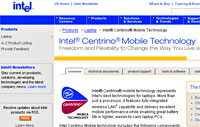 Intel has been bigging up its next-generation laptop technology, claiming they will use 25 percent less power while retaining class-leading performance.
Intel has been bigging up its next-generation laptop technology, claiming they will use 25 percent less power while retaining class-leading performance. According to Intel’s marketing chief for mobile platforms, Keith Kressin, this process means that the Napa system (which includes the Yonah processor, its attendant chipset and a new wireless chip) will soak up 28 percent less power than its predecessor while managing to perform 68 percent better
According to Intel’s marketing chief for mobile platforms, Keith Kressin, this process means that the Napa system (which includes the Yonah processor, its attendant chipset and a new wireless chip) will soak up 28 percent less power than its predecessor while managing to perform 68 percent better The tough challenge for Intel’s engineers is shoehorning ever more powerful processors into ever-slimmer laptops while improving battery life and managing to dissipate the processor’s heat.
The tough challenge for Intel’s engineers is shoehorning ever more powerful processors into ever-slimmer laptops while improving battery life and managing to dissipate the processor’s heat.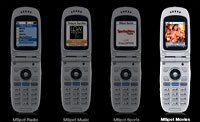 Sprint and MSpot, have announced the launch of MSpot Movies, a new service which streams mobile-optimised feature films to mobile phones.
Sprint and MSpot, have announced the launch of MSpot Movies, a new service which streams mobile-optimised feature films to mobile phones.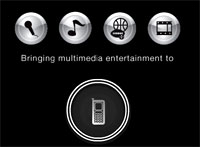 The streaming content will be cut up into ‘chapters’ (short segments optimised for a mobile audience) and will also include music concerts and stand-up comedy specials.
The streaming content will be cut up into ‘chapters’ (short segments optimised for a mobile audience) and will also include music concerts and stand-up comedy specials. Although there’s no denying that mobile video is set to grow – Strategy Analytics reckon they’ll be 150 million viewers by 2008 – we really can’t raise much enthusiasm at the prospect of burning up our bandwidth by watching a selection of crap movies on a tiny screen in 5 minute chunks.
Although there’s no denying that mobile video is set to grow – Strategy Analytics reckon they’ll be 150 million viewers by 2008 – we really can’t raise much enthusiasm at the prospect of burning up our bandwidth by watching a selection of crap movies on a tiny screen in 5 minute chunks.